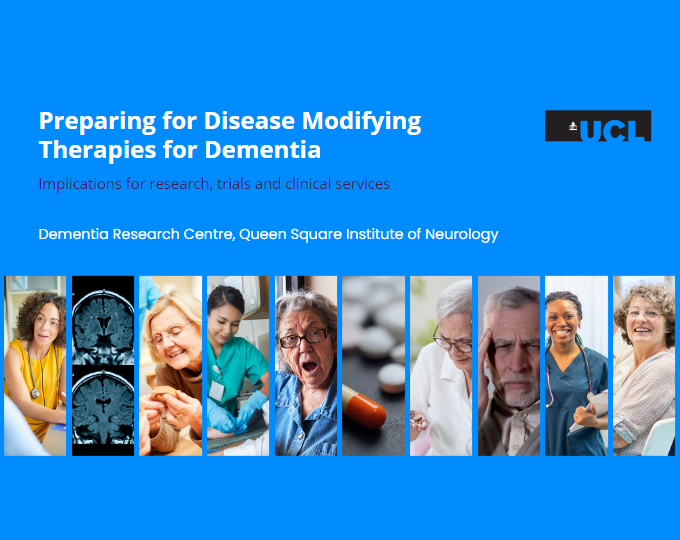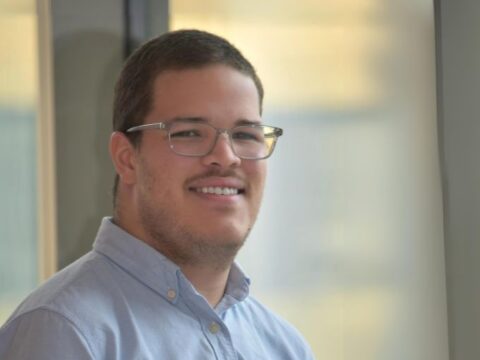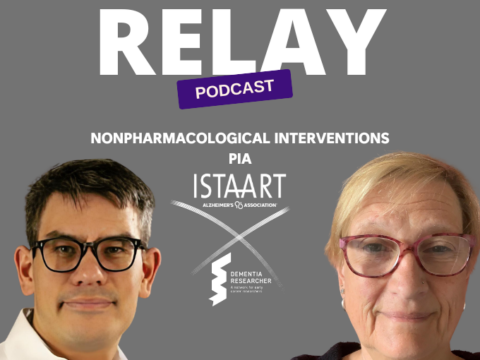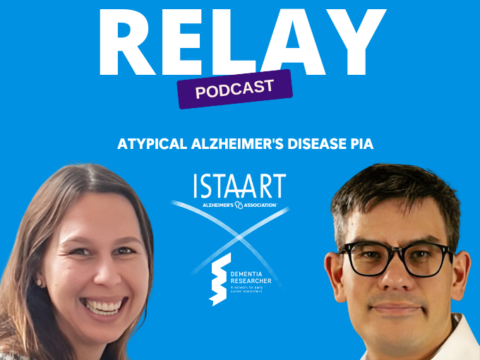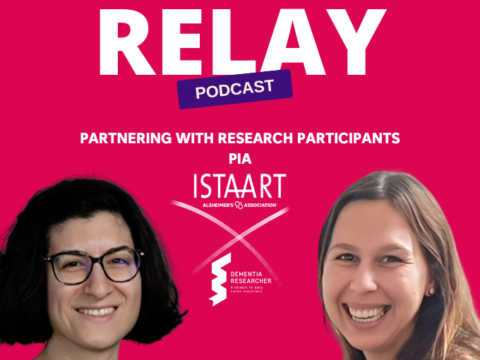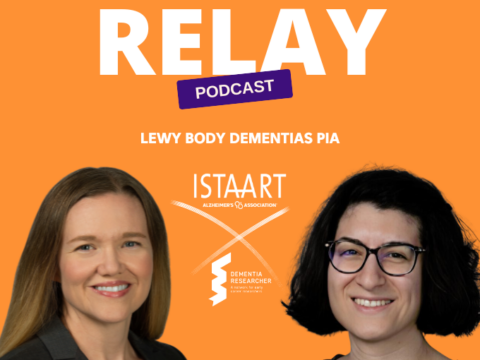In this special ISTAART Research Retrospectives Dr Claire Sexton interviews Professor Alison Goate discussing her research and her seminal papers on the amyloid precursor protein gene.
Alison M. Goate, DPhil, is the Jean C. and James W. Crystal Professor of Genomics, Chair of the Department of Genetics and Genomic Sciences, Professor of Neuroscience and Neurology, and faculty of the Icahn Genomics Institute at the Icahn School of Medicine at Mount Sinai. She has worked on the genetics of neurodegenerative diseases including Alzheimer’s disease (AD) and Frontotemporal Dementia (FTD) since 1987, and is the founding director of the Ronald M. Loeb Center for Alzheimer’s Disease at Mount Sinai.
Over the last three decades, Dr. Goate has been part of many gene finding teams that have successfully identified disease-causing variants for both AD and FTD. While working at Imperial College in London, she reported the first mutation to cause familial Alzheimer’s disease, and her early studies at Washington University in St. Louis identified a genetic mutation in Colombian families that are now part of the Alzheimer’s Prevention Initiative clinical trial. Her lab was also part of the team that first reported MAPT mutations in FTD.
Professor Goate is also a leader in the study of late onset AD genetics using integrative genomic approaches to identify novel genetic risk factors. Her work led to the identification of Trem2 as a risk factor for AD and has highlighted the enrichment of AD risk variants in microglial enhancers, regulatory elements in DNA that control gene expression in immune cells of the brain. Professor Goate is now building upon these insights using genome editing in induced pluripotent stem cells to understand the molecular mechanisms of disease and to develop novel therapeutics.
Professor Goate has received the Potamkin Award from the American Academy of Neurology, the Khalid Iqbal Lifetime Achievement Award from the Alzheimer’s Association, the Rainwater Prize, and the MetLife Award for herresearch on AD. She was elected a fellow of the American Association for the Advancement of Science in 2012, and a fellow of the National Academy of Medicine in 2016.
Professor Goate will be attending the Alzheimer's Association Tau 2024 Conference - find more information at https://www.alz.org/tau
Voice Over:
Behind the Breakthroughs, conversations with dementia research pioneers on ISTAART research retrospectives.
Dr Claire Sexton:
Hello, my name is Claire Sexton, and it's my pleasure to be chatting today with Dr. Alison Goate and to go on this research retrospective of her incredible career. Alison, welcome.
Professor Alison Goate:
Thank you, Claire.
Dr Claire Sexton:
So today we will be discussing two of your landmark papers. The first, segregation of a missense mutation in the amyloid precursor protein gene with familial Alzheimer's disease was published in nature in 1991. And the second, integration of Alzheimer's disease genetics and myeloid genomics identifies disease risk regulatory elements and genes was published in Nature Communications in 2021. So firstly, can you believe that 30 years passed between the publication of those two papers?
Professor Alison Goate:
In some ways, yes, but in some ways, no. Right? The time went by very rapidly and frustrating that we are only now having therapeutics that are focused on amyloid in the clinic when the mutations were found 30 years ago. That's discouraging to think it took so long.
Dr Claire Sexton:
It took a long time, but we're there.
Professor Alison Goate:
We are there, yes.
Dr Claire Sexton:
So first, if we go back to your first publication in 1991 that we'll be discussing, you at that time at St. Mary's Hospital Medical School in London. Would you be able to set the scene for us then?
Professor Alison Goate:
Yeah, sure. So I started working with John Hardy in 1987 as a senior postdoc. And then in 1989 I got a Royal Society University Research Fellowship. And so I started developing my own independent projects. So by 1991, there was some of my own projects and this project that I started with John on the familial Alzheimer's disease. I got married in 1987, had my first child in 1991 so it was a busy four years. And obviously the fact that the paper came out at that time when I was pregnant was obviously very busy year in 1991.
Dr Claire Sexton:
And you mentioned that then you are working on familial Alzheimer's disease.
Professor Alison Goate:
Right.
Dr Claire Sexton:
Would you be able to share with our listeners a bit more about what familial Alzheimer's is? What was known about the causes back in 1991 and what motivated you.
Professor Alison Goate:
So for genetic studies, these familial forms of Alzheimer's disease were really important. So they're pretty rare, but there's a clear mode of inheritance. So if you have an affected parent with early-onset familial Alzheimer's disease, you are at 50% risk of developing disease yourself. And so for geneticists, then that clear mode of inheritance means that you can use familial approaches to study the disease. So what John and I did was, with Martin Rossor, collect families in the UK where there were multiple cases of Alzheimer's disease in people, be it below the age of 60, and it was these families that we used for the study in that nature paper.
Dr Claire Sexton:
And by studies involving these families, then you're able to discover that there was a mutation in the APP gene in two unrelated families with familial Alzheimer's. This was the very first suggestion, if I might, that some cases of the disease could be caused by mutations in APP. And you've described how this was changed the trajectory of your career.
Professor Alison Goate:
Yeah. So actually back in 1987, there were several papers published that said that there weren't mutations in the amyloid precursor protein gene. And so people made a false conclusion from... So in at that time, everyone thought there was going to be one gene that caused these familial forms of Alzheimer's disease, and therefore, if you could exclude a mutation in APP in one family, you excluded that idea in all families. And so that kind of set us back. That was actually the time I joined John's lab in 1987. And so then we started using a pure reverse genetics approach to identify the regional chromosome 21 where we had linkage already, but to try and narrow it down and find which gene it was. And so we were quite fortunate that among the families we were studying, we had a family that we really couldn't rule out APP. There was a strong signal just above the APP gene and so we went back and sequenced APP and then found a mutation in that family.
So that really changed everything because then people started looking at individual families. And obviously, we know now there are quite a few families that have mutations in APP, but for that period of four years, everyone assumed that there weren't mutations in APP. So it means always be mindful and careful when you're doing your studies right, because that was a false conclusion that sent everybody in the wrong direction for several years. But yeah, no, I mean, that always really a groundbreaking study that allowed us in the field to develop animal models, to develop cell models, which we never had before. To study the disease in the late '80s, you basically used brain tissue from people who died of Alzheimer's disease. So you're looking at the end stage of disease. Finding the mutations allows you to create cells and animal models that carry these mutations. And they don't produce Alzheimer's disease, but they mimic some of the molecular processes. And at least in the animals, you get amyloid deposition. And so it allowed people to study that process and ultimately to develop therapies, obviously.
Dr Claire Sexton:
Yeah. And at the time, did you have an inkling of how big this finding was?
Professor Alison Goate:
I think yes and no, right? I mean, I definitely... Knowing that we had a cause of disease, but not really fully understanding at the time what proportion of cases might be affected by it or how useful any of the models might be. I mean, obviously today, 30 years later, we're still using the amyloid models that were made in the '90s to study amyloid deposition in mice. And it certainly, for me personally, it definitely changed the trajectory of my career. There were times before we found that the mutation that I had thought that I might need to get out of science because I hadn't published very much. I didn't think I was particularly competitive to get a faculty position. And so I was trying to think what I might do next. And obviously, this paper changed all of that. So for me, it was a huge deal.
Dr Claire Sexton:
Gosh, that's amazing. So it was really a springboard for you and for the field.
Professor Alison Goate:
Yes.
Dr Claire Sexton:
And now, if we fast-forward 30 years now, the focus of your work has evolved from discovering these kind of rare causal genes to deciphering more common genetic risk factors. And advances in methods were crucial, it seems to this evolution that. There was GWAS studies by you and many others that contributed to a shift in focus for the field, looking beyond just amyloid and also tau, but understanding the complexity of the disease and placing a spotlight on the immune system in particular. And this paper that we're going to discuss in 2021 in Nature Communications employed such a variety of different measures to then connect genetic risk with Alzheimer's with changes in microglial gene expression. Could you share a bit about how the methods in genetic research changed over that time the impact that it's had?
Professor Alison Goate:
So you're right that really GWAS wasn't possible before. The earliest GWAS studies were in about 2006. And really big studies didn't happen until 2010 or around there. I think the revolution that happened was basically having a chip that you could look at DNA variation in millions of places in the genome simultaneously in one individual, but then you can multiplex that and do hundreds, thousands, tens of thousands of people. We were doing that all by hand.
So in 1991, a polymerase chain reaction was new, right? A PCR machine with three water baths, different temperatures, and you move things one water bath to another. So obviously you're not going to look at hundreds of thousands of variants or even thousands of people if that's some kind of approach. So really it was technological advances that made things happen.
I think the other thing that is really different between the two eras is it was a race in 1991, right? That you could only win that race if you had families in your collection that carried a mutation in APP, right? So some people didn't have it, but also the glory went to the people who got there first, right? Now, human genetics for complex diseases is a collaborative process, right? That nobody can do this alone. We all work together. It's team science. And so I think that's a huge difference in the way we approach our work now compared with them.
Dr Claire Sexton:
I'd love to unpack that a bit more. What does team science mean to you?
Professor Alison Goate:
I think working with groups and teams around the world with a common cause to solve a problem. And people in that team come with different expertise and view the problem from different angles. I think that those things make doing this kind of research exciting and invigorating. And to me, it's much more satisfying to be involved in that kind of team science. I mean, for us in 1991, the team was our individual lab, whereas I would say now it's people working on genetics of Alzheimer's disease all around the world. That's the larger team and that we need each other in order to accomplish our goals.
Dr Claire Sexton:
And that approach then allows you to publish those types of papers like your 2021 paper. Where can you see the impact of that paper having then in the coming years?
Professor Alison Goate:
Yeah, I mean, I would say so it's not just that paper, but I would say over the last maybe just under 10 years, there's been a realisation of the importance of the immune system in Alzheimer's disease that wasn't previously appreciated, right? And so I can remember going to Alzheimer meetings where discussion of the role of microglia in Alzheimer's disease was at the last session on the last day and most people were already left to go home, whereas now it's the plenary on day one. And so I think that that shows you how much the field has changed its thinking.
And it was really started, I think, with the discovery of TREM2. But since then, it's become clear through our work and other people's work that the majority of genetic risk for late onset Alzheimer's disease is found in microglial express genes. And so that I think is really important for moving the field beyond amyloid and tau, right? I mean, it's clear that we desperately need novel targets and novel approaches. Most other complex diseases, cancer, heart disease, we have lots of different ways of trying to treat those diseases. And right now on Alzheimer's disease, we do not. And so that's really important to be able to broaden our horizons in that respect.
Dr Claire Sexton:
Completely. And so I think you've brought us up to speed with how the field has changed in its focus, how the methods has changed over this time, how the nature of collaborations has changed, but I wanted to touch upon how your environment changed too over this time, going from working in London to then living in New York City. So what type of impact did that have?
Professor Alison Goate:
So I would say part of the reason that I moved was that in the early '90s, research funding and Alzheimer's disease was not all that great it in the UK. And when I moved to the US, I discovered the Alzheimer's Disease Research Centre programmes by NIH. I think that that's been a tremendous programme for supporting Alzheimer's research in generating well-characterised cohorts for study. So from the research perspective, definitely the move was related to being able to do the best research that I can do. I love living in Manhattan this stage in my life. I don't think I could have brought my kids up there. I did that in St. Louis, and it was a good place to bring up my kids. I think that now they probably feel more American than they do British, but they had carry both passports. So yeah, I mean, I think having brought up my family in the US, that's probably sort of a big difference. All of my extended family still lives in the UK.
Dr Claire Sexton:
But the US is home now. Would you-
Professor Alison Goate:
Yeah, it is. I mean, suddenly while I'm still working, I really can't imagine moving back. And see, I don't really want to move again. Moving is disruptive. So no, I've made my home in New York at this point.
Dr Claire Sexton:
So on that note, I would like to thank you, Alison, for sharing such important insights over 30 years of a stellar scientific career. And here's to another 30.
Professor Alison Goate:
We'll see, yes. Thank you much very much, Claire. It was fun talking with you.
Voice Over:
Behind the Breakthroughs, conversations with dementia research pioneers on ISTAART research retrospectives.
END
Like what you hear? Please review, like, and share our podcast - and don't forget to subscribe to ensure you never miss an episode.
If you would like to share your own experiences or discuss your research in a blog or on a podcast, drop us a line to dementiaresearcher@ucl.ac.uk
This podcast is brought to you in association with the Alzheimer's Association, who we thank for their ongoing support.
The views and opinions expressed by the host and guests in this podcast represent those of the guests and do not necessarily reflect those of UCL or Dementia Researcher

 Print This Post
Print This Post


